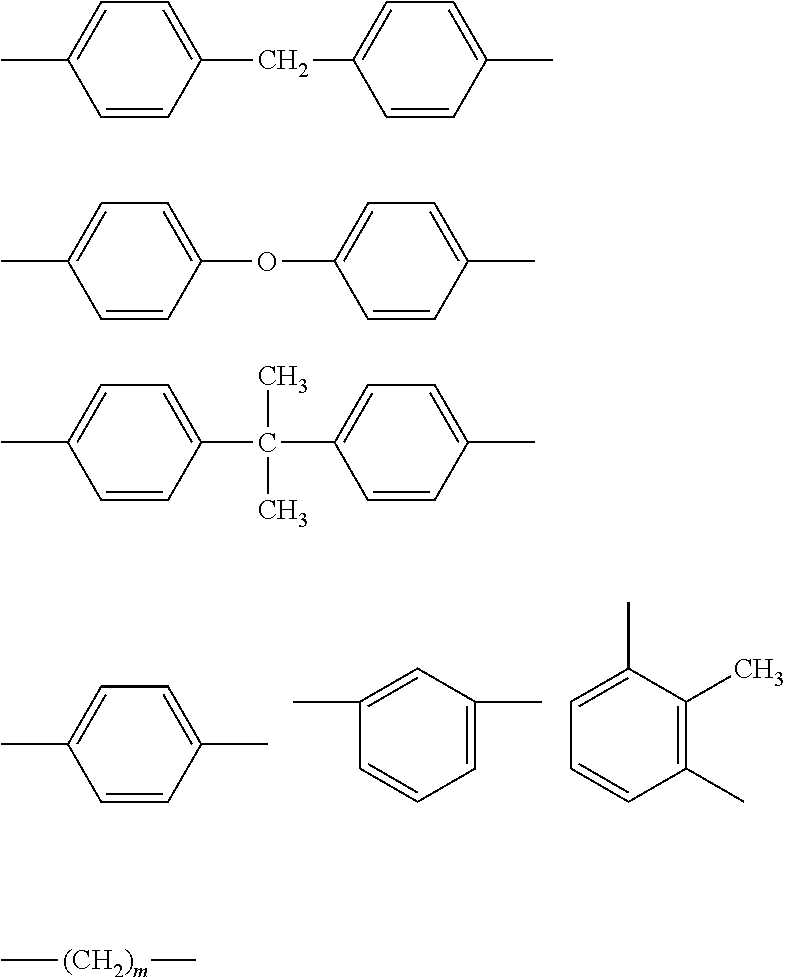Amorphous polyetherimide fiber and heat-resistant fabric
a technology of amorphous polyetherimide fiber and heat-resistant fabric, which is applied in the direction of monocomponent polyether artificial filament, melting spinning method, etc., can solve the problems of inability to obtain amorphous pei fibers having a small fineness, fatal to achieve the above needs, and poor forming of amorphous pei polymers, etc., to achieve excellent mechanical properties, small fineness and heat-resistance
- Summary
- Abstract
- Description
- Claims
- Application Information
AI Technical Summary
Benefits of technology
Problems solved by technology
Method used
Image
Examples
example 1
[0078](1) An amorphous PEI polymer (“ULTEM 9001” produced by SABIC Innovative Plastics Holding) having a weight-average molecular weight (Mw) of 32,000 and a number average molecular weight (Mn) of 14,500 (molecular weight distribution: 2.2) are dried at 150° C. under vacuum for 12 hours.
[0079](2) The polymer obtained in the above (1) was melt kneaded and the molten polymer having a melt viscosity of 2,000 poise measured at a temperature of 390° C. and shear rate of 1,200 sec−1 was discharged from the nozzle having round holes, in the condition of the spinning head temperature of 390° C., the spinning rate of 2,000 m / min. and the discharge amount of 50 g / min. to produce multi-filaments having 220 dtex / 100 f. The performance evaluation of the obtained fiber is shown in Table 1.
[0080](3) The appearance of the obtained fiber was good and no fluff was observed. The fiber had a single fiber fineness of 2.2 dtex, and both the mechanical property and the heat-resisting property of the fibe...
example 2
[0081](1) Except for spinning at a spinning rate of 1,800 m / min. the fiber was obtained in the same way as Example 1. The performance evaluation of the obtained fiber is shown in Table 1.
[0082](2) The appearance of the obtained fiber was good and no fluff was observed. The fiber had a single fiber fineness of 3.0 dtex, and both the mechanical property and the heat-resisting property of the fiber were excellent because the fiber had a tenacity of 2.5 cN / dtex, a shrinkage percentage under dry heat at 200° C. of 3.1%, and an LOI value of 31. Moreover, the number of fiber breaking times was 2 times in the spinning test with the use of 100 kg polymer as there was no pressure fluctuation etc., and the spinning stability was determined as good.
example 3
[0083](1) An anatase type titanium oxide (“TA-300” produced by Fuji Titanium Industry Co., Ltd.) was added to the polymer in Example 1 (1) in an amount of 40 mass % relative to the polymer, and the mixture was melt kneaded to obtain a master batch. The obtained master batch was mixed to the polymer in Example (1) so as to produce a polymer blend for forming a fiber comprising the anatase type titanium oxide at a concentration of 0.5 mass % relative to the polymer. Except for using the polymer blend, the fiber was obtained in the same way as Example 1. The performance evaluation of the obtained fiber is shown in Table 1.
[0084](2) The appearance of the obtained fiber was good and no fluff was observed. The fiber had a single fiber fineness of 2.2 dtex, and both the mechanical property and the heat-resisting property of the fiber were excellent because the fiber had a tenacity of 2.5 cN / dtex, a shrinkage percentage under dry heat at 200° C. of 2.5%, and an LOI value of 31. Moreover, th...
PUM
| Property | Measurement | Unit |
|---|---|---|
| shrinkage percentage | aaaaa | aaaaa |
| molecular weight distribution | aaaaa | aaaaa |
| shrinkage percentage | aaaaa | aaaaa |
Abstract
Description
Claims
Application Information
 Login to View More
Login to View More - R&D
- Intellectual Property
- Life Sciences
- Materials
- Tech Scout
- Unparalleled Data Quality
- Higher Quality Content
- 60% Fewer Hallucinations
Browse by: Latest US Patents, China's latest patents, Technical Efficacy Thesaurus, Application Domain, Technology Topic, Popular Technical Reports.
© 2025 PatSnap. All rights reserved.Legal|Privacy policy|Modern Slavery Act Transparency Statement|Sitemap|About US| Contact US: help@patsnap.com



